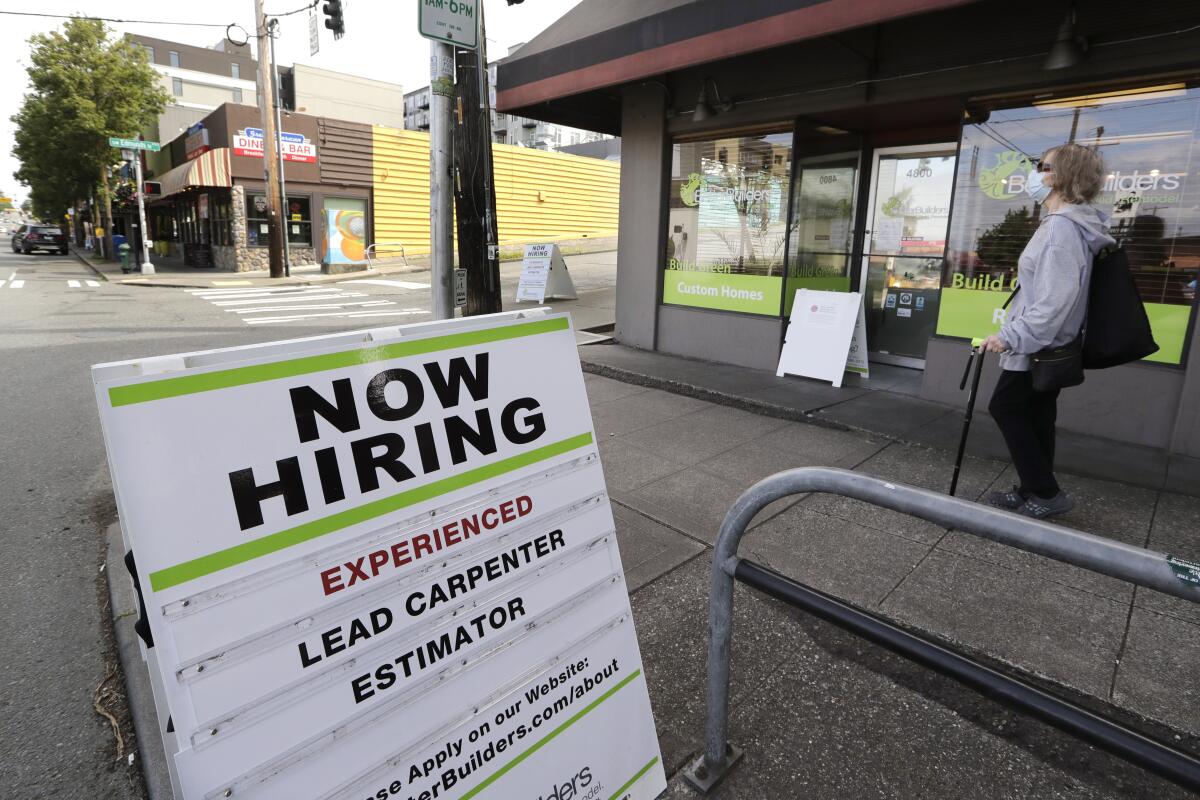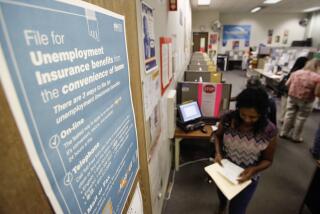Why two months of U.S. job gains doesn’t mean the economy has rebounded from the corornavirus

- Share via
WASHINGTON — Accelerating job growth in June and a second straight month of declining unemployment fanned hopes for a fast recovery after the economy suffered near-Great Depression losses in the spring.
But the better-than-expected jobs report Thursday, which showed unemployment dropping to 11.1% from 13.3% and employers adding 4.8 million jobs in June, may be an uncertain guide to the future.
Even as President Trump hailed the report as evidence of an economy “roaring back,” and defended his handling of the health crisis, coronavirus cases, as well as hospitalizations and infections among younger Americans, have been exploding in California and other states across the West and South.
As a result, many areas that were reopening for business, and thus beginning to call back workers, are reversing course and imposing restrictions again.
“This report may be a kind of high point,” said Heidi Shierholz, a former Labor Department chief economist now at the Economic Policy Institute. Moreover, she noted that significant portions of the federal government’s pandemic relief package are scheduled to expire in a few weeks.
“We may see we’re losing jobs in coming months,” Shierholz said, barring new action by Congress and Trump to extend the programs.
California’s employment numbers for June will be released July 17 and are likely to mirror the national trend, albeit at a weaker pace. The state’s jobless rate for May was 16.3%, little changed from April, as job creation lagged somewhat. Unemployment in Los Angeles County was 20.9% in May.
Even with the June gains, joblessness overall stands well above the 3.5% rate in February and remains higher than at any time since the Bureau of Labor Statistics’ records began in 1948.
Jobless rates dropped across the board in June. The gap between men and women narrowed to just 1 point. Other disparities remain significant, however. Black unemployment was 15.4% compared with 14.5% for Latinos, 13.8% for Asians and 10.1% for white people. Unemployment for college graduates was down to 6.9% versus 12.1% for workers with only a high school education.
The Bureau of Labor Statistics said the overall unemployment rate for the nation might actually be 1 percentage point higher than the 11.1% reported because of complications in survey collection. Misclassification of workers’ status had resulted in a much bigger undercount of the unemployed in the prior two months.
Separately Thursday, the Labor Department said 1.43 million people applied for unemployment benefits last week. That was the fourth week in a row in which around 1.5 million workers filed new jobless claims — six times more than the average before the pandemic — indicating continued stress in the labor market.
The country overall lost 22 million payroll jobs in March and April, and including the May gain of 2.7 million payrolls, has now regained about one-third of the losses. But that doesn’t include millions of workers whose hours have been reduced to part time. And millions of others have dropped out of the labor force because they don’t see much out there or are staying on the sidelines because of health concerns.
For California, as well as the country as a whole, pandemic-induced layoffs were most concentrated in leisure and hospitality — mainly restaurants and hotels — and then retail stores and health and social services.
In June, the leisure and hospitality sector added 2.1 million new jobs, or two-fifths of the total new payrolls over the month.
In May, California trailed in recovering those jobs, reflecting in part a slow reopening of businesses and the state’s disproportionate dependence on tourism and trade.
Los Angeles and San Francisco, for example, have lost thousands of Chinese tourists who once arrived on some 150 weekly flights from parts of China, said Manfred Keil, chief economist at the Inland Empire Economic Partnership. That’s all stopped with the pandemic.
“We’re going to recover in a slow, step-wise fashion,” he said.
Some workers have transitioned into new industries. Elizabeth Clews, a 25-year-old single mom, was laid off in April from her waitressing job at the Bakersfield Sports Arena. She used her savings and the government’s pandemic relief check to buy a used car, and last month moved in with a friend in Oxnard. She now works as a driver for DoorDash and Postmates, app-based delivery services that have taken off during the crisis.
“I’m considered a top dasher,” Clews said proudly. “I can’t imagine going back to a restaurant job.”
Clews was caught in one of the early rounds of pandemic-induced layoffs that began with low-wage work such as food services, barbershops and movie theaters. She’s now counted as among the employed.
More recently, the effect of the coronavirus-triggered recession has spread to higher-paying professional and technical work.
One sign of that can be seen in job openings. Since early June, as more local and regional economies reopened across the country, the job search site Glassdoor has seen a solid bounce-back in openings for consumer services, including travel and tourism and beauty and fitness.
But job openings in media, information technology, computer software and accounting and legal services have dropped. Consistent with that, Thursday’s jobs report showed employment in computer systems design and related services fell by 20,000.
“As the demand from businesses and consumers decreases, then economic uncertainty increases, and there’s just less demand to actually hire new workers, even in industries where remote work is possible,” said Daniel Zhao, Glassdoor’s senior economist. “This is kind of like a second wave effect rippling through the economy as a result of the COVID-19 crisis.”
Analysts say unemployment might rise in coming months as a result of surging COVID-19 cases, or if people who dropped out of the labor force return to seek jobs, and thus will be counted as unemployed.
In addition, the summer usually brings a flood of fresh college graduates entering the job market — and this year they are stepping into one of the worst job markets in history, said Amanda Stansell, a senior research analyst at Glassdoor.
As of May, she said, the number of open jobs on Glassdoor that contain “entry level” or “new grad” in the job title was down 68% from this time last year.
The unemployment rate for workers ages 20 to 24 was 19.8% in June, double that for prime-age workers ages 25 to 54 and for older workers.
For the millions of workers on furlough, the big concern is whether their layoffs turn into permanent separations. That’s particularly worrisome to economists. Historically, the longer a worker remains unemployed, the darker prospects become for regaining a job at the previous level.
In June, employers in California provided 621 notices of impending layoffs affecting more than 55,000 workers. About 42% of the notifications were for permanent layoffs or because of closures.
In April and May, although there were many more layoff notices issued by employers, less than 20% were reported as permanent or in anticipation of closures, according to the state Employment Development Department.
“Each week employers are making calculations to turn furloughs and reduced hours into [permanent] layoffs, and in some cases they’re deciding they can’t go on,” said Michael Bernick, former EDD director who is now an employment attorney with Duane Morris in San Francisco.
For Corey Harris, the next few weeks will be crucial for his small business.
The 36-year-old owns a pair of restaurants in Oklahoma City called Off the Hook Seafood and More, a Cajun specialty that started out as a food truck in 2013.
Harris closed both diners when the outbreak hit in March but has since reopened, gradually bringing back his 20 employees, including five last month. He said it helped a lot that he got funds from the Paycheck Protection Program — forgivable loans that were part of the COVID-19 relief package approved by Congress.
Harris said his diners also have benefited from a growing interest in supporting Black-owned businesses in the wake of George Floyd’s death and nationwide protests. But now, Oklahoma City and other cities and states around the country are renewing warnings and starting to reimpose restrictions after a surge in COVID-19 cases and hospitalizations.
“It’s really getting out of hand,” Harris said Tuesday, when the state recorded a daily record of nearly 600 cases. “I don’t think we should have gone too fast,” he said of reopening policies. “I’m definitely concerned. I’m worried about their shutting down again.”
Times staff writer Chris Megerian contributed to this report.
More to Read
Get the L.A. Times Politics newsletter
Deeply reported insights into legislation, politics and policy from Sacramento, Washington and beyond. In your inbox three times per week.
You may occasionally receive promotional content from the Los Angeles Times.











